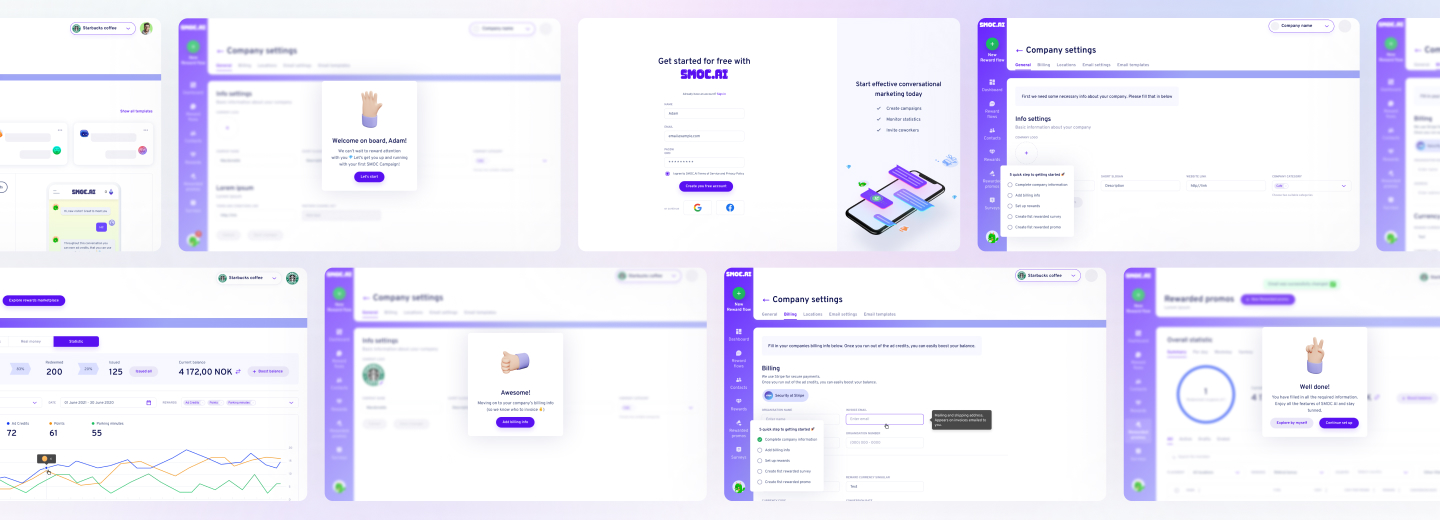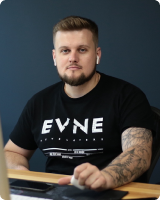I have spent a decade building products, hiring engineering teams, and advising founders who needed to get from a blank page to a shipping product. The reality is not glamorous. Good engineering hires compound everything you do right and punish everything you do poorly. When founders ask how to hire a programmer for a startup, they usually expect a job board link. What they need is a system that respects speed, signal quality, and the human side of long-term collaboration.
This is that system. It scales from your first developer to your first ten, and it respects your runway, your milestones, and your culture. If you want a shortcut you can execute, keep reading the article.
WHAT'S IN THE ARTICLE
How to ensure you find the right team
Hiring programmers for a startup begins long before you post a role. It starts when you can frame the work as a clear problem with measurable outcomes. First of all, you should define your personal business goals that the team has to achieve.
- What is the single most valuable technical outcome in the next 90 days?
- What are the non-negotiable constraints? Time to first release, security requirements, regulatory boundaries, and scalability targets.
- What work exists today, and how is it documented? Specs, wireframes, API contracts, data models.
- What will success look like by week 2, week 4, and week 12?
Replace wishlists with outcomes. Instead of “full-stack wizard,” try “deliver a working, secure MVP with auth, billing, and admin dashboard that can handle 1,000 daily active users by March 15.”
Clarity turns the question of how to hire programmers into a repeatable process. It also helps you validate whether you need a generalist, a specialist, or a hybrid.
Remote, hybrid, or onsite: choose with intent
Remote unlocks broader talent and better speed to hire. Onsite can accelerate early product formation if your team is local. Hybrid works with discipline.
- Remote: invest in writing, set core collaboration hours, record decisions, run crisp standups
- Onsite: design focused collaboration windows, quiet hours, clear meeting policies
- Hybrid: define days in-office, avoid second-class remote experience, double down on documentation
Think about the work. Hard hardware integration or lab work may demand proximity. Web product iteration often thrives remotely.
Contractors, agencies, or employees
The best option depends on scope, control, and runway.
- Contractors: great for scoped modules, migrations, or clearly defined integrations. Use for surge capacity or spike prototypes. Sign strong IP agreements.
- Agencies: useful when you need a pod fast. Demand senior ownership, insist on code quality guardrails, and require you own the repo and infrastructure. Evaluate their lead’s calendar and who actually writes code.
- Employees: critical for core product, long-term maintainability, and culture. They set standards, hold code context, and hire others.
When deciding how to hire a developer for startup milestones under time pressure, a mixed model is common. One senior employee sets the foundation and standards. A contractor or two fills gaps. A hire follows to absorb the work permanently.
Who to hire first: role architecture by stage
Early-stage hiring is not about titles. It is about leverage. The correct profile depends on what you must ship and how quickly you need to adapt.
| Startup Stage | Core Goal in 90 Days | Ideal Profile | Risk Profile | Notes |
| Pre-product | Validate problem-solution fit | Senior full-stack with product sense | Lower speed if over-engineered | Ship ugly, learn fast, avoid heavy infra |
| MVP build | Launch something real | Senior builder with DevOps basics | Rework if tech choices are misaligned | Choose boring tech, optimize for delivery |
| Post-MVP | Stabilize and learn | Backend plus mobile or frontend specialist | Burnout risk if generalist stretches too thin | Add QA automation early |
| Early growth | Scale and improve reliability | Backend lead, SRE, data person | Hiring debt if standards are weak | Introduce code review and metrics |
| Seed to Series A | Build engine for iteration | Team lead plus 2 to 4 ICs, product engineer | Process drag if over-structured | Define career ladders and compensation bands |
If you are finding programmers for a startup at idea stage, bias toward someone who can build end to end and make product decisions. At growth stage, optimize for reliability and speed of iteration.
Build a skills scorecard and use it religiously
A clean scorecard fights bias and shortens time to hire.
- Must have: the 4 to 6 competencies that directly map to your 90-day goals. Example: implement secure OAuth flows, design normalized relational schema, set up CI that runs tests under 5 minutes.
- Nice to have: things that help but do not block shipping. Example: Next.js experience, GraphQL proficiency, Terraform basics.
- Non-negotiables: values and work style. Ownership, collaborative feedback, documentation discipline, calm under pressure.
- Signals: exact behaviors or outputs that prove competency. Link each to a scoring rubric.
Example scoring rubric for “Ownership”
- 1: Needs tasks broken down, escalates frequently without proposals
- 2: Accepts tasks, completes with some guidance, communicates blockers
- 3: Proactively defines work, unblocks themselves, resolves ambiguity
- 4: Anticipates risks, influences priorities, mentors others on ownership
Tie hiring a programmer for a startup to these rubrics. No exceptions.

Looking to Build an MVP without worries about strategy planning?
EVNE Developers is a dedicated software development team with a product mindset.
We’ll be happy to help you turn your idea into life and successfully monetize it.
How to keep your team until product scaling
Compensation and equity without regret
You want someone who will act like a partner. Pay them fairly, show the upside, and avoid surprises. Here is a simple structure that works.
- Salary bands anchored to market data in your geography. Calibrate by seniority and scarcity.
- Equity that is meaningful and real. Standard 4-year vesting with 1-year cliff, but consider front-loaded vesting for very early hires.
- Benefits that help productivity. Health coverage, hardware stipend, home office support, smart conferences.
- Signing bonus only when timing is tight. Keep it simple and transparent.
Equity example for a first senior engineer
- Salary: 150k to 180k, region dependent
- Equity: 0.5 percent to 1.0 percent post-option pool, standard vesting
- Rationale: top 3 technical contributor, expected to shape architecture and hiring
Simple dilution math for context
- Pre-seed founders own 80 percent combined after pool setup
- Option pool set to 15 percent
- First hires take 2 percent total
- New seed round adds 20 percent dilution
- Net impact: founders at 64 percent, option pool refreshed to 10 to 15 percent as needed
A small table to frame compensation mix by stage
| Stage | Cash Emphasis | Equity Emphasis | Notes |
| Pre-seed | Low to moderate | High | Equity tells the truth about upside |
| Seed | Moderate | Moderate to high | Balance runway and hiring speed |
| Series A | Moderate to high | Moderate | Teams expect stronger cash plus clarity on path |
Be honest during offers. Do not hide risk. Engineers respect candor.
The subtle art of product sense in engineers
Founders often ask how to hire programmers who can think like product partners. This matters at every stage.
Signals of product sense:
- Proposes simpler features that hit the same user goal
- Questions assumptions about default states, error states, and offline behavior
- Measures what they ship and acts on the data
- Writes small, meaningful PRs that map to user stories
Interview prompt that surfaces this:
You must add team permissions to a dashboard. Propose roles, think through edge cases, and sketch the migration plan. How do you roll this out without locking out admins?
The best engineers reduce user pain and engineering risk in one move.
Create an environment where great programmers want to stay
Hiring is the first win. Retention is the compounding effect. People stay where they can do the best work of their career with people they trust.
- Career growth paths, even if simple at first
- Clear roadmap that respects learning
- Psychological safety for admitting mistakes and fixing them
- Tempo that avoids heroics and protects health
- Documented decisions and a habit of writing
- Visible progress, regular demos, and authentic recognition
Legal, IP, and compliance checklist
Get these right from day one. Keep templates ready so you do not lose candidates during paperwork delays.
- Access control: principle of least privilege, offboarding checklist
- Proper entity setup and cap table management
- Invention assignment and confidentiality agreement for every contributor
- Background checks where it is lawful and proportionate
- Data processing agreements and basic privacy posture
- Open-source license review for dependencies, plus a policy for new libraries
- Vendor security review for critical services
Where to find great programmers, fast
The fastest way to hire programmers for startup teams is to go where signal lives. Avoid generic posts that read like copy-paste. Anyone strong will ignore them.
- Agencies can help, but manage incentives and insist on transparency
- Warm referrals from trusted engineers and product leaders
- Open-source contributors who touch your tooling stack
- Technical communities that match your domain, think dbt for analytics or Rust forums for systems work
- Targeted outbound on GitHub and LinkedIn with custom notes
- Alumni networks, especially from companies shipping similar products
- Niche job boards for your stack
Outreach that earns a response
A clear, respectful message beats a wall of text. It should prove you read their profile and that the role is built for them. A good follow-up comes after three days. When founders ask how to hire programmers for a startup, they often overlook the simple act of showing respect in that first message. Respect communicates standard.
Outreach that earns a response
Speed matters when hiring developers for startup roles. You can capture strong candidates by running a tight, humane process.
- References with specific questions about shipping, quality, and recovery from failure
- 20-minute intro call focused on outcomes and constraints
- 60-minute technical screen using real code or a focused debugging session
- Optional take-home work sample that mirrors your product and takes 90 minutes or less
- Culture and collaboration interview that probes habits, not buzzwords
Work samples over puzzles
Skip brainteasers. Use a scoped task that looks like your backlog.
- Add a feature to a small repo with tests
- Refactor a function to improve readability and performance
- Write an integration that hits a real API with basic auth and rate limits
Time-box to 90 minutes. Offer an alternative: pair on the task live if they prefer.
Live collaboration tests
Set up a 60-minute pairing session.
- Look for a clean mental model and an ability to simplify
- Describe the user story and acceptance criteria
- Ask them to drive for 30 minutes and you drive for 30 minutes
- Observe how they ask questions, structure work, and handle confusion
Systems design and product sense
Even at early stages, ask for small-scale design. Do not turn it into a cloud diagram marathon.
Prompt: Design a simple notifications service for our app that can send emails and push messages. Discuss data model, retries, idempotency, and failure handling. Measure what matters first, then talk about scaling.
Signal comes from tradeoffs, not fancy naming.

Proving the Concept for FinTech Startup with a Smart Algorithm for Detecting Subscriptions

Scaling from Prototype into a User-Friendly and Conversational Marketing Platform
Interview loop that predicts startup performance
A great loop is short, fair, and anchored to the scorecard.
Suggested loop over 1 to 3 days:
- References: 2 to 3 calls, 15 minutes each
- Intro call: mutual fit, 20 minutes
- Technical screen: code walkthrough or pairing, 60 minutes
- Design and product sense: architecture and reasoning, 60 minutes
- Culture and ownership: behaviors, communication, learned lessons, 45 minutes
- Founder chat: vision, runway, ways of working, 30 minutes
Behavioral signals that matter
- Ownership: finds clarity in chaos, proposes solutions, does not wait for permission on obvious fixes
- Communication: concise updates, visibility into tradeoffs, proactive risk calls
- Taste: chooses boring tech when it speeds delivery, reduces accidental complexity
- Pragmatism: tests the right things, ships incrementally, fixes debt before it compounds
- Resilience: recovers from failures with learning and calm
Technical depth indicators
- Strong fundamentals: data structures, complexity thinking used sparingly and wisely
- Debugging: systematic approach, hypothesis driven, uses logs and metrics, isolates variables
- Testing: understands boundaries, mocks correctly, values integration tests
- Security: applies least privilege, avoids secrets in code, respects data handling requirements
- DevOps: sets up CI quickly, favors infra as code, budgets for observability
Red flags
- Talks in buzzwords, thin on specifics
- Over-indexes on purity, rejects pragmatic tradeoffs
- Dismisses documentation or process as busywork
- Blames teams for past failures without owning their part
- Slow to respond or disorganized during the loop with no context
Deciding, offering, and closing with integrity
Speed again wins. Make the decision within 24 hours of the final interview.
- Collate scorecards before debating
- Write a one-paragraph hiring justification tied to outcomes
- If it is a no, say it quickly and give one helpful insight
Closing steps:
- Offer a trial day paid session if they want more signal
- Verbal offer with salary, equity, benefits, and start date
- Send a clean, readable offer letter
- Share your vision memo and product roadmap
- Provide references to you, so they can reference-check the company
Onboarding that pays off in the first month
Onboarding can either create speed or debt.
Week 0
- Prepare laptop, access, repos, credentials
- Send architecture overview and product brief
- Assign a buddy and a small starter task
Week 1
- Ship a small change to production
- Review coding standards, runbook, on-call basics if applicable
- Schedule pairing sessions with adjacent roles
Week 2
- Own a minor feature end to end
- Lead a design review for a small change
- Write or improve documentation
Week 4
- Take ownership of a component or service
- Propose a tech debt item and fix it
- Demo work to the team and reflect on process changes
This is how hiring a programmer for a startup can quickly turn into value.
Funnel math that respects your runway
Track your pipeline like a product funnel. It tells you how many candidates you need at the top to hit your hires at the bottom.
| Stage | Typical Conversion | Notes |
| Sourced or inbound | 100 percent | Top of funnel |
| Positive response | 25 to 40 percent | Outreach quality drives this |
| Intro call passed | 60 to 80 percent | Be selective before scheduling |
| Technical screen passed | 30 to 50 percent | Good tasks filter quickly |
| Onsite loop passed | 40 to 60 percent | Scorecard discipline matters |
| Offer extended | 70 to 90 percent | Calibrate bar to stage |
| Offer accepted | 50 to 80 percent | Speed and clarity win here |
If you want one hire in 30 days, and your accept rate is 60 percent, you likely need 2 offers. With a 50 percent on-site pass rate, you need 4 final loops. Reverse that math to sourcing. Plan for 30 to 60 strong leads to begin.
Real-world scenarios
Scenario 1: Pre-seed, 6 months runway, B2B SaaS, no code written
- Goal: shipping a paid pilot with two design partners in 90 days
- Hiring plan: one senior full-stack product engineer employee, one part-time contractor on frontend polish
- Stack: React, Node, Postgres, Docker on a managed platform, simple CI, basic monitoring
- Cost: 165k salary pro-rated, 0.75 percent equity, contractor at 80 per hour for 20 hours weekly
- Why: one accountable owner backed by flexible capacity
Scenario 2: Seed, 18 months runway, consumer mobile app, prototype exists
- Goal: stabilize iOS app, add analytics, grow to 5k DAU
- Hiring plan: iOS senior, backend with growth analytics skills, part-time designer
- Stack: SwiftUI, Kotlin or cross-platform choice if justified, backend in a language your team knows, events collection pipeline
- Notes: invest in crash reporting, release process, and AB testing early
Scenario 3: Post-seed, data-heavy product, strong inbound interest
- Goal: build the data ingestion layer, first ML model in production
- Hiring plan: backend data engineer with streaming experience, MLOps-minded engineer, part-time SRE
- Stack: Python, dbt, Airflow or Dagster, warehouse first, feature store later
- Guardrails: security and privacy hygiene early, clearly defined SLAs for data freshness
These are the patterns I repeat when founders ask how to hire programmers for a startup under real constraints.
When each method leads the conversation
- Early idea stage: start with top down market analysis to avoid building for tiny niches by accident. Then sketch a minimal bottom-up plan to show you know how revenue happens.
- Post-MVP with a handful of customers: lead with bottom-up market analysis tied to actual conversion, price, and churn. Keep a top-down number in the appendix for context.
- Growth rounds: run both in detail. Use the hybrid approach to justify the hiring plan and channel bets.
Moving between the two isn’t a sign of weakness. It’s a sign you care about reality.
Tools for hiring with speed and quality
- ATS: Ashby or Lever, light automation with readable scorecards
- Coding tasks: GitHub Classroom, a private repo with GitHub Actions for tests
- Sourcing: LinkedIn Recruiter Lite, GitHub search, niche boards
- References: standardized form with 4 to 6 targeted questions
- Notion or Coda: candidate briefs, interview plan, decision docs
- Slack channel for each role: centralize updates, reduce drift
- Calendly or Motion: eliminate scheduling friction
Keep your toolchain simple. The best tool is a disciplined hiring manager with a clear plan.

Need Checking What Your Product Market is Able to Offer?
EVNE Developers is a dedicated software development team with a product mindset.
We’ll be happy to help you turn your idea into life and successfully monetize it.
A practical checklist you can run this week
- Write a 90-day outcomes brief for the role
- Build a four-part scorecard with rubrics
- Draft a succinct outreach message with a product brief attached
- Prepare a 90-minute work sample repo with tests
- Schedule a tight interview loop across two days
- Define an offer range with equity ready
- Line up two references you can offer to the candidate
- Draft an onboarding plan for week 1 and week 4
Repeat this for every role until it becomes muscle memory. That is how to hire programmers at startup speed without compromising quality.
Conclusion
Our practical guide can help you build your first startup team and gain success in the field. It is important to start with a strong foundation with reliable specialists ready to add to your expertise. Ensure you build long-term relationships with the team members through specific techniques and behaviour patterns. With the right approach, you can build trust and create a reliable team ready for new beginnings and capable of reaching your business success.
If this playbook resonates and you want help applying it to your product, I run a startup development and consulting practice that builds teams and ships outcomes. I am happy to send a sample scorecard, an offer template, or a one-page hiring plan tuned to your milestones. Share your challenge and your timeline, and I will reply with a concrete plan and a short path to your first hire.
Hiring for a fantasy stack instead of a ship-ready stack
Letting process drag for weeks and losing the best candidates
Outsourcing all quality thinking to agencies without code ownership
Treating candidates like vendors instead of future partners
Overvaluing cleverness over reliability and taste
Ignoring the comp realities of your geography and stage
Skipping reference checks or asking weak questions
The average time to hire a developer for a startup can range from 25 to 35 days.

About author
Roman Bondarenko is the CEO of EVNE Developers. He is an expert in software development and technological entrepreneurship and has 10+years of experience in digital transformation consulting in Healthcare, FinTech, Supply Chain and Logistics.
Author | CEO EVNE Developers


















